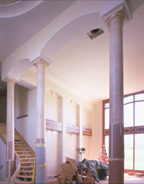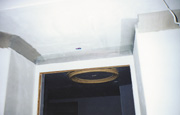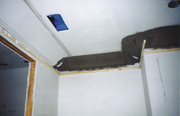

The owner opted for plaster in his new home because of plaster's flexibility and because he desired a skip-trowel finish on all the walls.
Mullennix Plastering, of Dayton, Ohio, was contracted to do all the walls and ceilings, as well as the ornamental mold work. Ed Mullennix, along with sons Chad and Todd and plasterer, John Aungst, did all the work. Admittedly, the company is accustomed to doing repair work, but slowly it's getting more new-construction jobs.
"New housing and plaster are not that common and it is taking awhile for the new-housing industry to come around," says Chad Mullennix. "However, I think a lot of people are starting to realize the options plaster offers, including textures you can't get with drywall."
Mullennix attributes the lack of plaster in new housing to many factors. He believes people may not be aware that plaster has been modernized like anything else with higher-quality products. There are even some plaster "urban legends," such as one customer telling Mullennix that plaster holds too much moisture in the house. A lack of plastering contractors also contributes to the product's rarity in new housing.

Skip the finish
The owner knew he wanted a Mediterranean look for the surface of his walls. Everything in the house is a thin-coat veneer plaster with blueboard behind it, a basecoat over the board and a skip trowel finish. Mullennix Plastering made up a sample of the texture and it was approved. However, the company was in for a surprise when the owner saw the first textured wall; he said he wasn't sure if he liked it."One thing you have to explain is that the unpainted texture looks a lot rougher than the final painted surface will look," Mullennix says. "When he said he wasn't sure if he liked it, we actually brought in a painter to paint the wall and deaden the rough texture. When the owner saw that, he said 'that's it.'"
The wall surface textures were accomplished with a sand finish and a wallpaper brush. The background was brushed and then another gauging was used to texture it.
Although the textured walls and the 22-foot ceiling in the great room gave the crew plenty to do, it was the ornamental work that appealed to Chad Mullennix. Several ceiling medallions, in addition to nearly 1,200 linear feet of mold work, challenged the skills of the company. On most of the molds, because of the size of them, metal lath was put in the angles and fastened to the studs. The finish, about 1/4 inch, consisted of lime and molding plaster.
Luckily, there was never any doubt whether the job could be done although on any project of this magnitude there can be surprises.
"The many angles and curves where molds had to be installed did force us to rethink our original approach," Mullennix explains. "We had to build down for the template to ride above the doors and had to do a little more prep work than I anticipated when setting up a mold to run."
Complicating this was the fact that there was mold work in almost every room: the kitchen, bedrooms, great room--even a smaller bathroom that required six miters.
"When you see the size of the rooms on the blueprint and add up the lineal feet of the molding, that's one thing, but when you have these small angles on the actual surface and have to put the miters in by hand, that takes time," Mullennix explains.
Mullennix says that these extra challenges did not damage the overall timetable of the job, which lasted five months. The guest side of the house was plastered first which had no molds, and gave the crew a feel for the finish. Another challenge was creating the ornamental ceiling medallions, which also did not quite match the blueprint.

Plaster medallions
The three ceiling medallions in the house are completely done in plaster."We made all our templates ourselves," Mullennix says. "We took a piece of metal and, based on the blueprint, cut the profile. Then we mounted the metal onto wood to back it up. We left the metal and left the wood on the back of the metal and that's the support. Then we hooked it up in the middle and spun it around, while we kept piling plaster in there."
Mullennix took heavy-gauge hanger wire and made holes around the wood frame to bring it down because the medallions are 5 1/2 inches off the ceiling.
"I didn't want to build all that weight up the blueboard so I took hanger wire and went up in the ceiling and wrapped the wire around the ceiling joist for extra holding," Mullennix adds. "Then I put metal lath on it, scratched it in with Structolite and accelerated it with aluminum sulfate. Water is used on the surface in the final stages to polish it up."
Although not accustomed to projects of this size, Mullennix hopes to get more work like this. His confidence is based on long years and different situations to become proficient, and doing a lot of repair work teaches one things about the nature of plaster in the field.
"I like doing ornamental work because it sets me apart from others," Mullennix says. "It's hard enough to find people that can do plaster, let alone ornamental plaster, and that's why I want to continue with it."

Report Abusive Comment